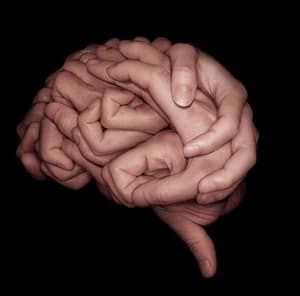
Why you are not only your brain:
Exploring Embodied Language
Second-year Psychology students participating in the University Honours College follow a mini-course on Blogging Science (within the Thematic Meetings course), in which they learn to communicate science to the general public, by means of informing, giving an opinion, and relating issues in science to issues in society. This year a selection of these written blog posts is published on Mindwise. Today’s post is by Elena Sophia Pohl .
In the 17th century Rene Descartes claimed that “there is a great difference between mind and body, inasmuch as body is by nature always divisible, and the mind is entirely indivisible… the mind or soul of man is entirely different from the body.” Dualism, which is the idea that mind is inherently different from the body, from thereon became one of the guiding principles in cognitive science and profoundly shaped western thought in general. The notion of the disembodied mind does not only influence our perception of mind-body relation, but additionally how we discern language and reasoning. If the mind is viewed as being distinct from our physical experiences in the world, language is often described as a rather disembodied process, too. But there is evidence that our body and our sensory- motor experiences shape the nature of symbolic expression and communication. Therefore, this post will explore how language might be more “embodied” than oftentimes assumed.
The Mind as a Computer
To start with, it is important to mention that most cognitive scientists today are not dualists like Descartes – they do not believe that the mind is physically distinct from the body. Still, many of them do not seem to realize enough, the importance the physical body has on the formation of mental experiences including language. This might be the case since throughout the past century the theoretical framework of cognitivism has mainly shaped how the mind is understood, in general and scientific terms. From this perspective, human intelligence is viewed as being analogous to the internal processes of modern computers. According to this analogy, the mind represents a computer program with the brain as its general- purpose hardware. Cognitive tasks are based on information processing and symbol manipulation which are governed by rules of logical inferences. Here, the body only represents an interface that converts sensory inputs into internal representation and from thereon produces relevant output.
When thinking about cognition, many people refer to the brain as its driving force. But when I picture myself and my experiences in the physical world, I do not feel like I am as simply constructed as a neural computer. When I go to grab a glass of water, for example, it is not like I “compute” this entire act before I execute it. I am sitting in a room, oriented in a certain way towards the glass (it is on the table to my left), I am looking at it from time to time, et cetera. When I extend my arm to grab the glass, it does not feel like a conscious, precisely calibrated decision. Rather, it feels like a decision embedded in my environment. This is a fundamentally different way of being than a computer. Theoretically, a computer could make a decision in a vacuum. A human being makes a decision in direct relation to his or her environment.
The view that our cognition is influenced or even determined by our experiences in the physical world is known as the theory of Embodied Cognition. According to this perspective, our cognition is not circumscribed to our cortices. Many features of cognition are influenced by the way we are embodied and how our physical body interacts with the environment it is situated in. Since mental experiences seem to be closely intertwined with our body, language might not only be viewed an assembly of abstract symbols but as a rather embodied process, too.
Embodied Language
We might feel that the idea that our cognition is grounded in our bodily experiences is a bit ‘over our heads’. Interestingly, we express our lack of understanding in terms of the physical inability to see something that is positioned over our head. The understanding that most of human cognition and even most abstract forms of reasoning are rooted in our sensorimotor system was first brought up by American cognitive linguist George Lakoff. In his book Metaphors we live by he points out that human thought is oftentimes metaphorical. Lakoff uses examples such as the fact that we understand control in terms of physical position. The person being in control, for example is often viewed as being UP, while someone who is subject to control is often described as being DOWN. We express being in control by saying ‘I am ON TOP of the situation’ or ‘I have control OVER him’. In addition, we might use physiological reaction of our body to express our emotion. Being angry, for example, if often understood metaphorically in terms of heat. This might be the case since perceiving anger is associated with physiological changes such as, increased body temperature and rising heart rate (Lakoff & Johnson, 1980). With these examples Lakoff wants to point out that the mind is embodied and that reasoning and language are not only grounded on abstract laws. Cognition is guidedby bodily experiences, which lead language and metaphors to not only reflect passive literacy devices, but our experiences and position in the physical world (Lakoff & Johnson, 1980). Overall, the embodiment of the mind is not only reflected in the semantics in our language. Language is also directly reflected by our physical body. Gestures, for instance, are a good example of how we express our cognition and reasoning using movements and bodily actions (Hostetter & Alibali, 2008). The aforementioned examples are only one way to illustrate that mind and body are not distinct, but intrinsically connected. They help us to picture the bi-directional and dynamic relationship between the mind and the body in which no component can be viewed as being of causal priority.
Unlike Descartes, I do not believe cognition works with a top-down model, the mind being “top”, and the body being “down”. Mind is not as sovereign a substance as Descartes and many thinkers with him may have believed or still believe. Our minds are influenced by our bodies, the environment, and various physical processes. And our cognition is arguably driven by our bodies, just as much as by our minds.
Note: Image from unknown artist, retrieved from SYNTHETIC ZERØ.
References
Hostetter, A., & Alibali, M. (2008). Visible embodiment: Gestures as simulated action. Psychonomic Bulletin & Review, 15(3), 495-514. doi:10.3758/PBR.15.3.495
Lakoff, G. & Johnson, Mark (1980). “Conceptual Metaphor in Everyday Language”. The Journal of Philosophy. 77 (8): 453–486. doi:10.2307/2025464
Lakoff, G. & Johnson, M. (1980) Metaphors We Live By. Chicago: University of Chicago Press.
Wilson, A. D., & Golonka, S. (2013). Embodied Cognition is Not What you Think it is. Frontiers in Psychology, 4. https://doi.org/10.3389/fpsyg.2013.00058
Wilson, R. A., & Foglia, L. (2017). Embodied Cognition. In E. N. Zalta (Ed.), The Stanford Encyclopedia of Philosophy (Spring 2017). Metaphysics Research Lab, Stanford University. Retrieved from https://plato.stanford.edu/archives/spr2017/entries/embodied-cognition/




I’m impressed